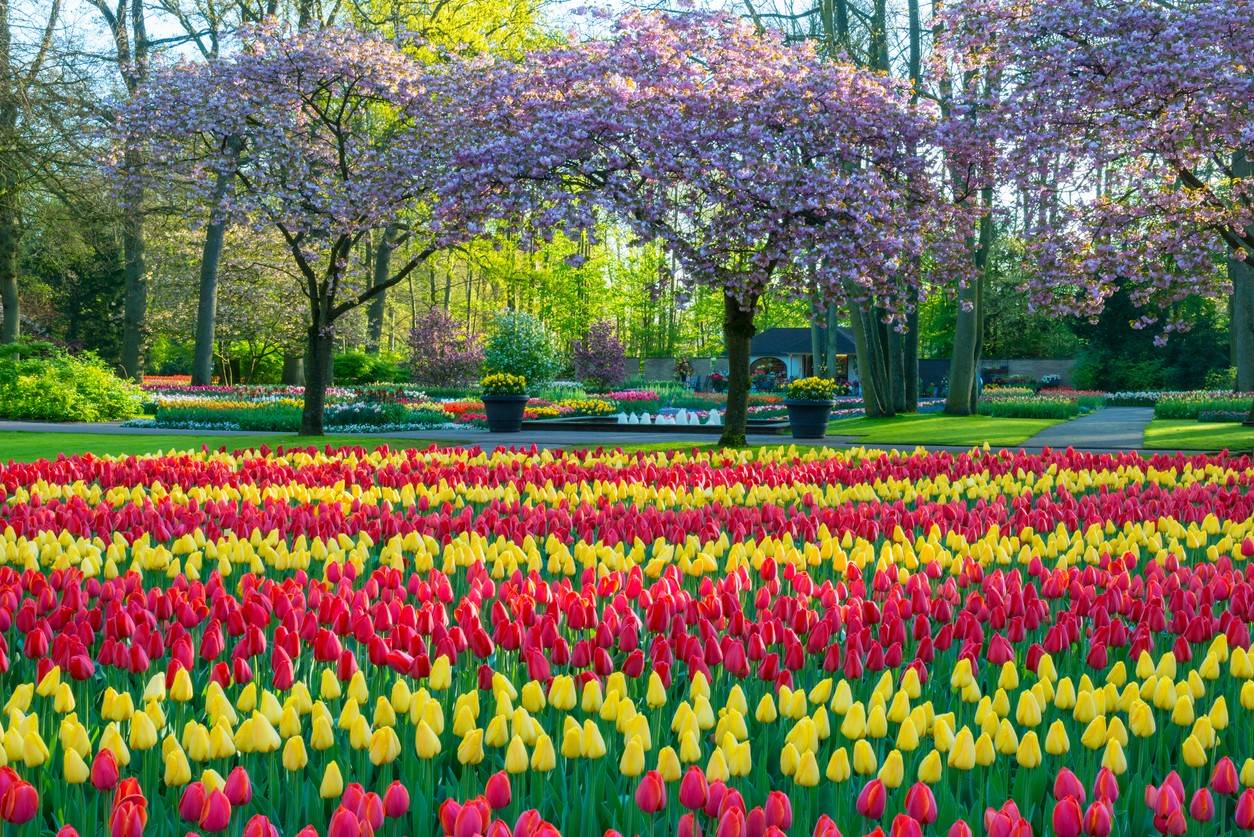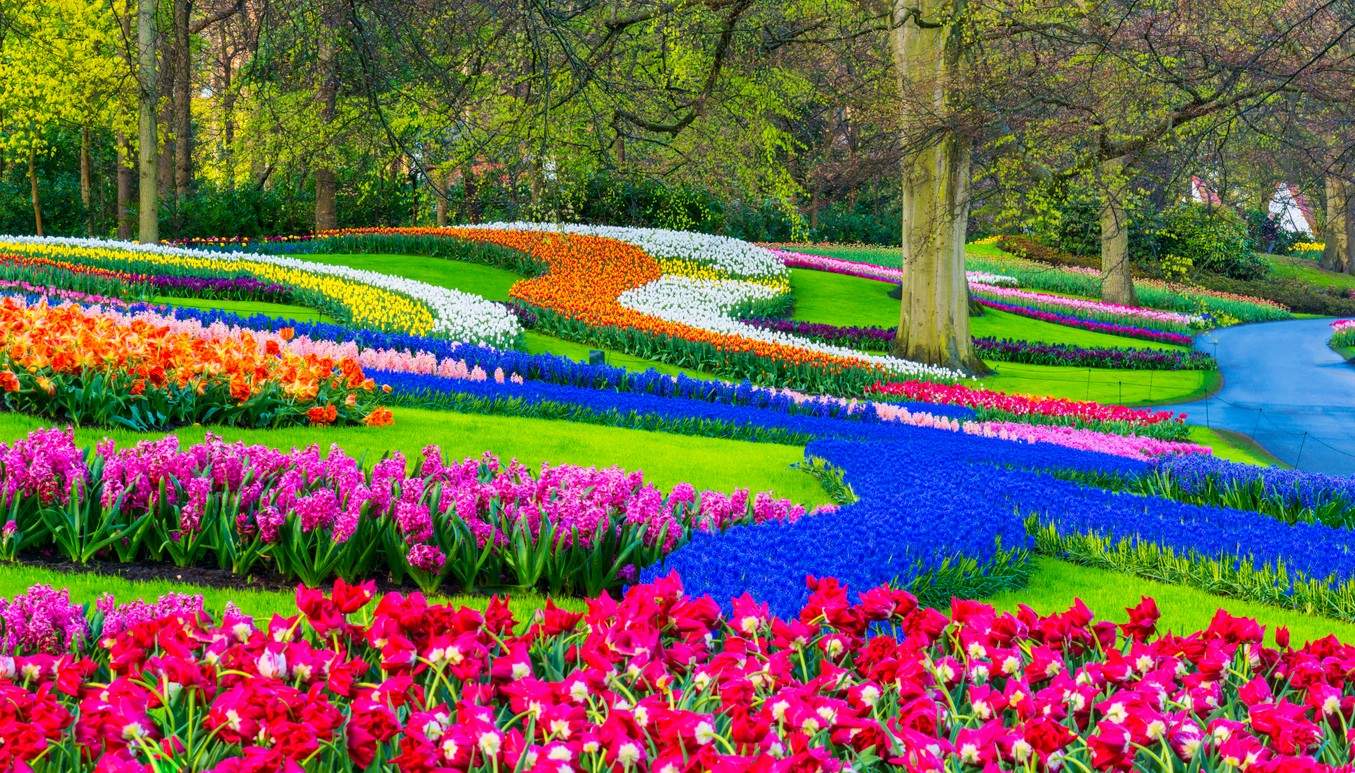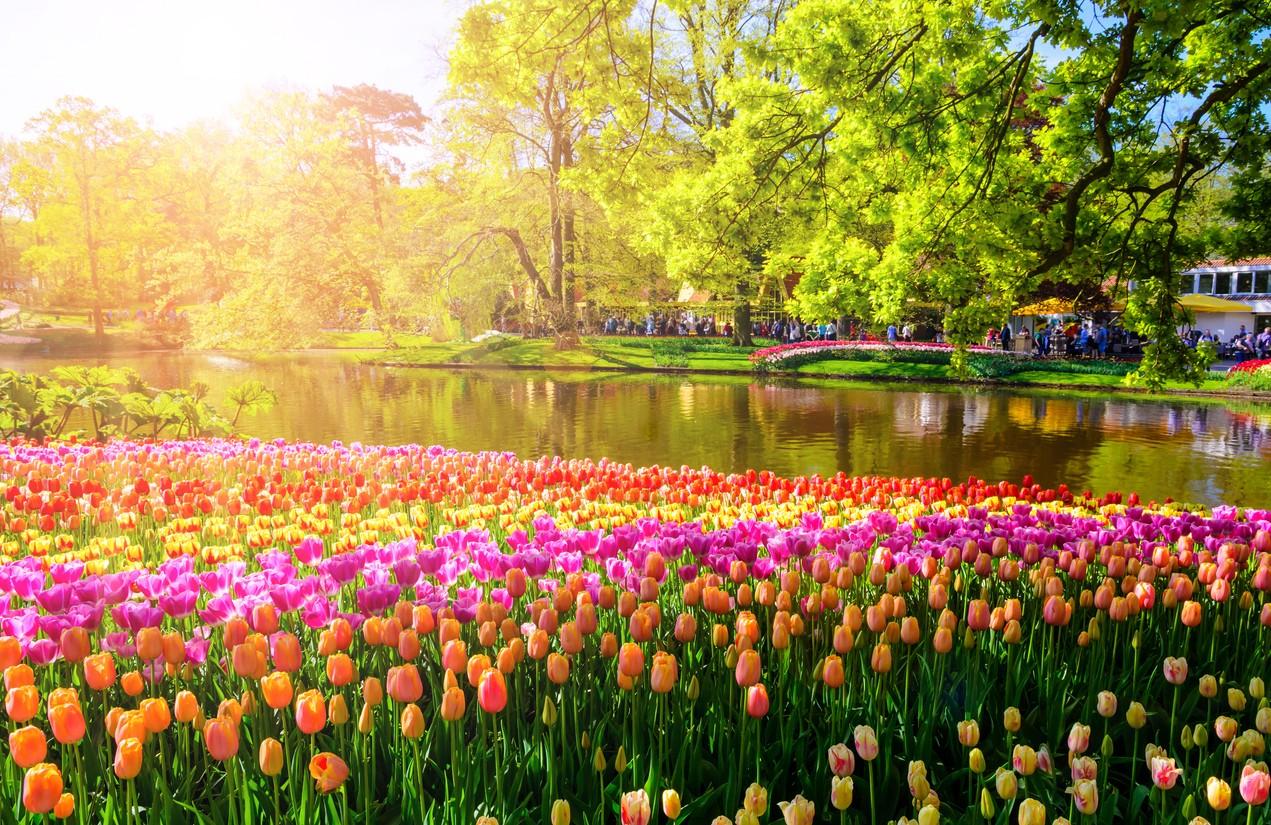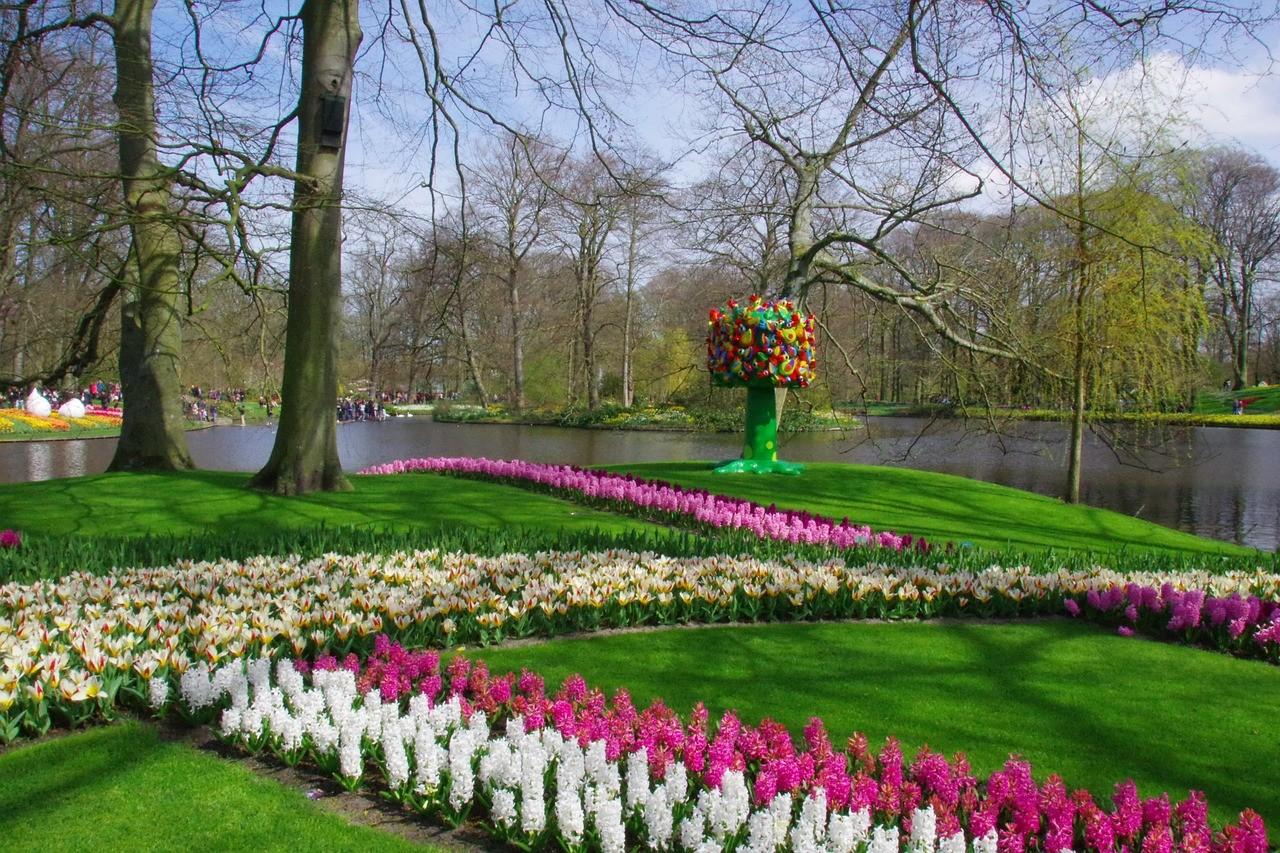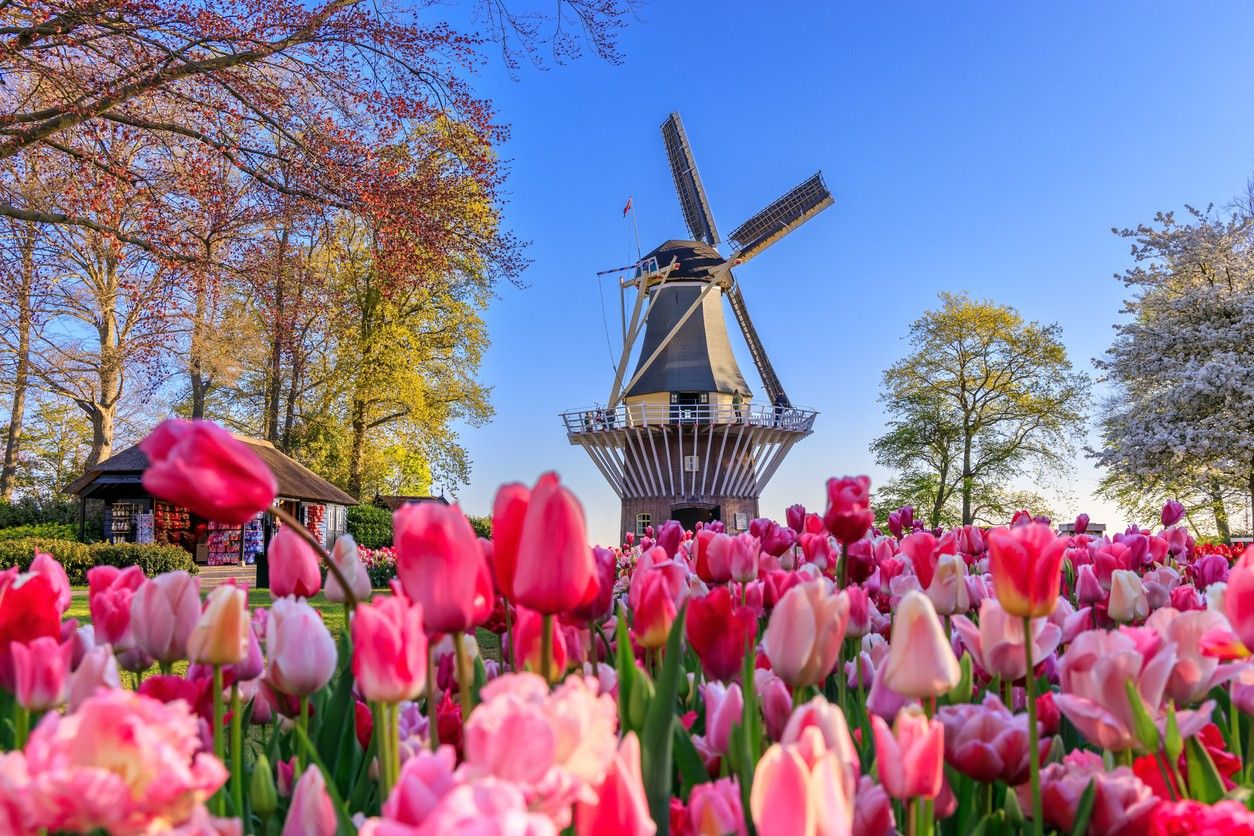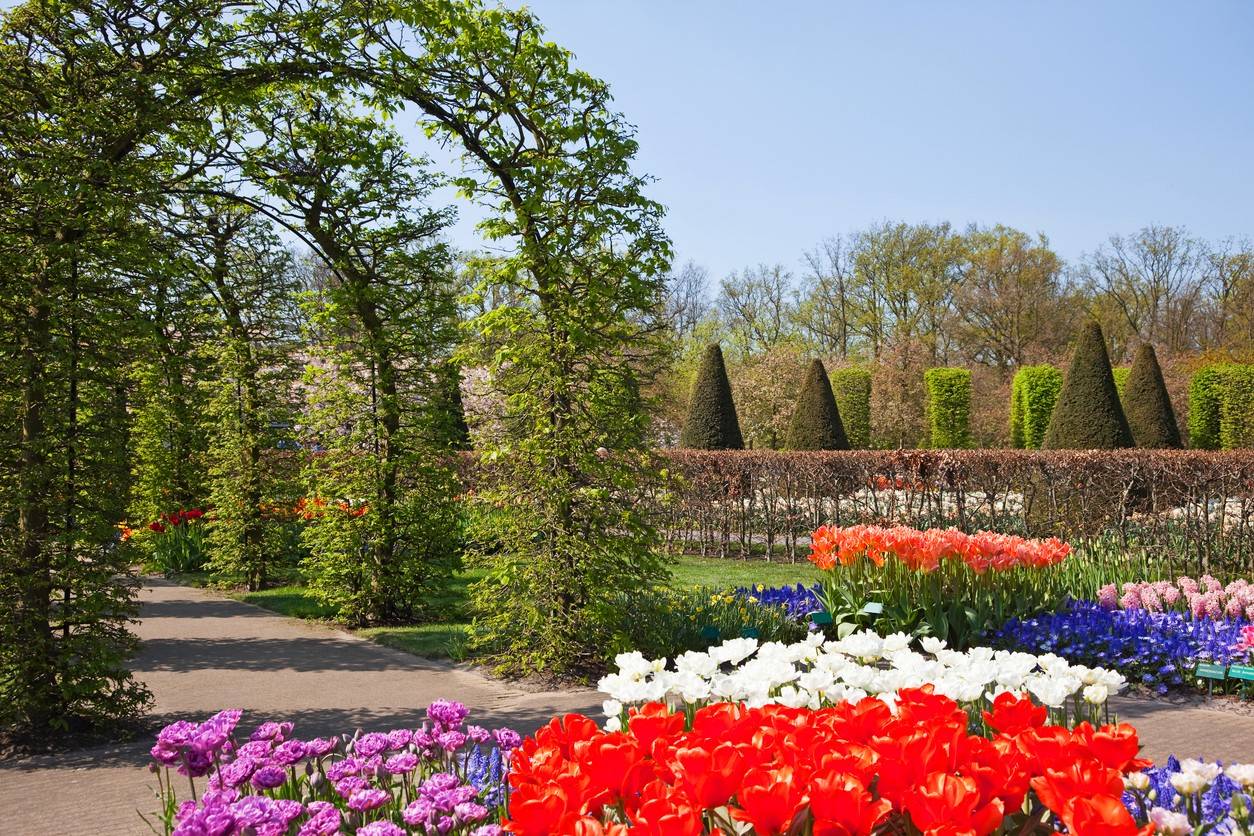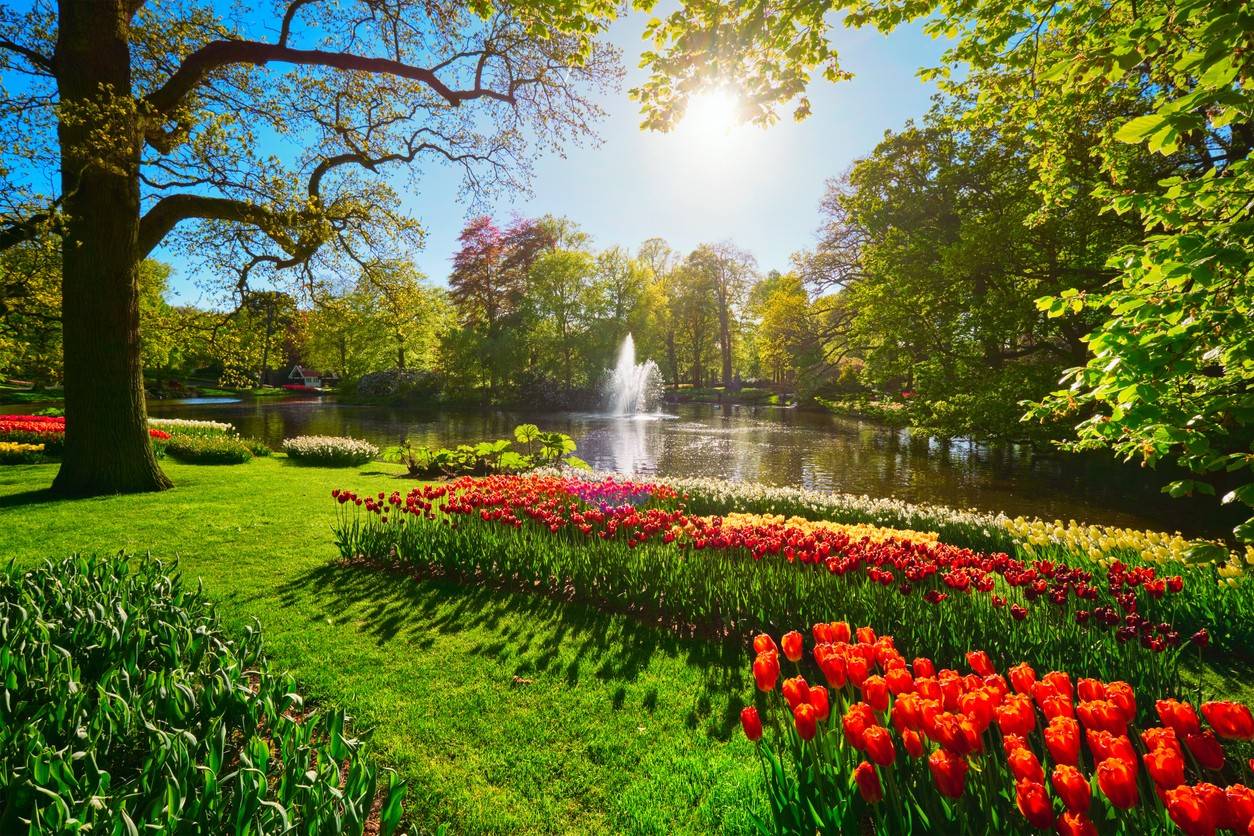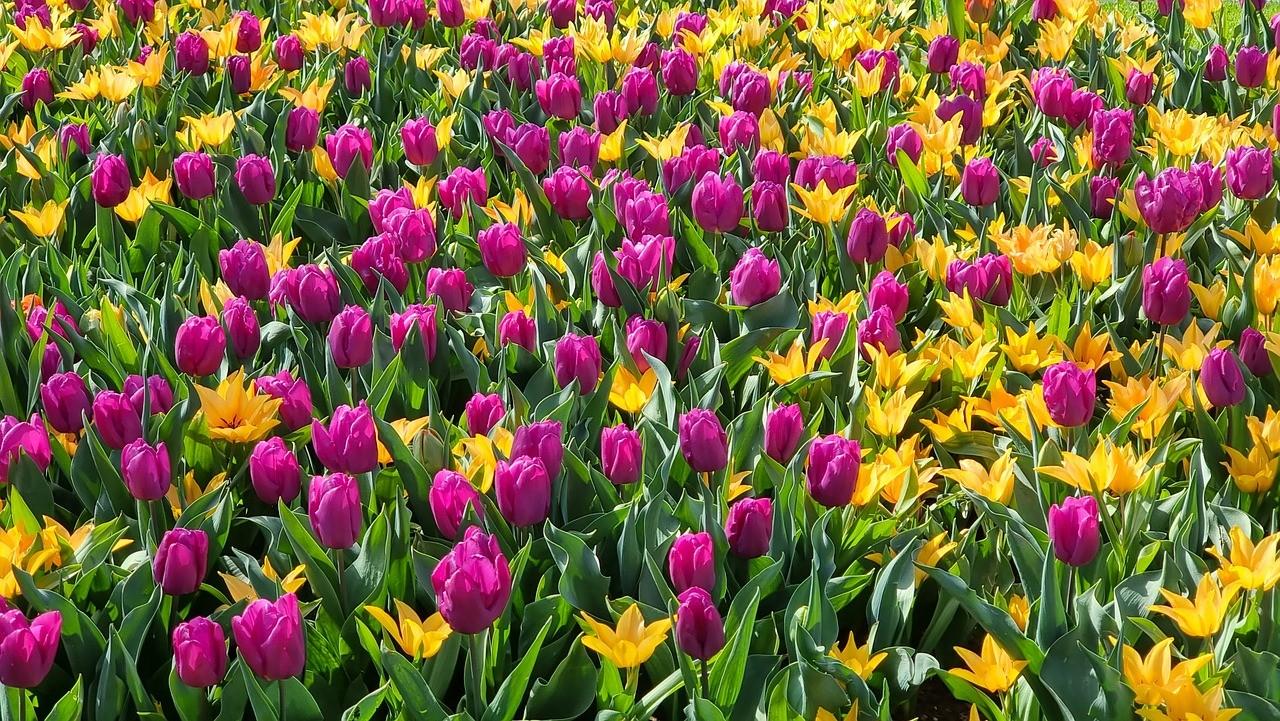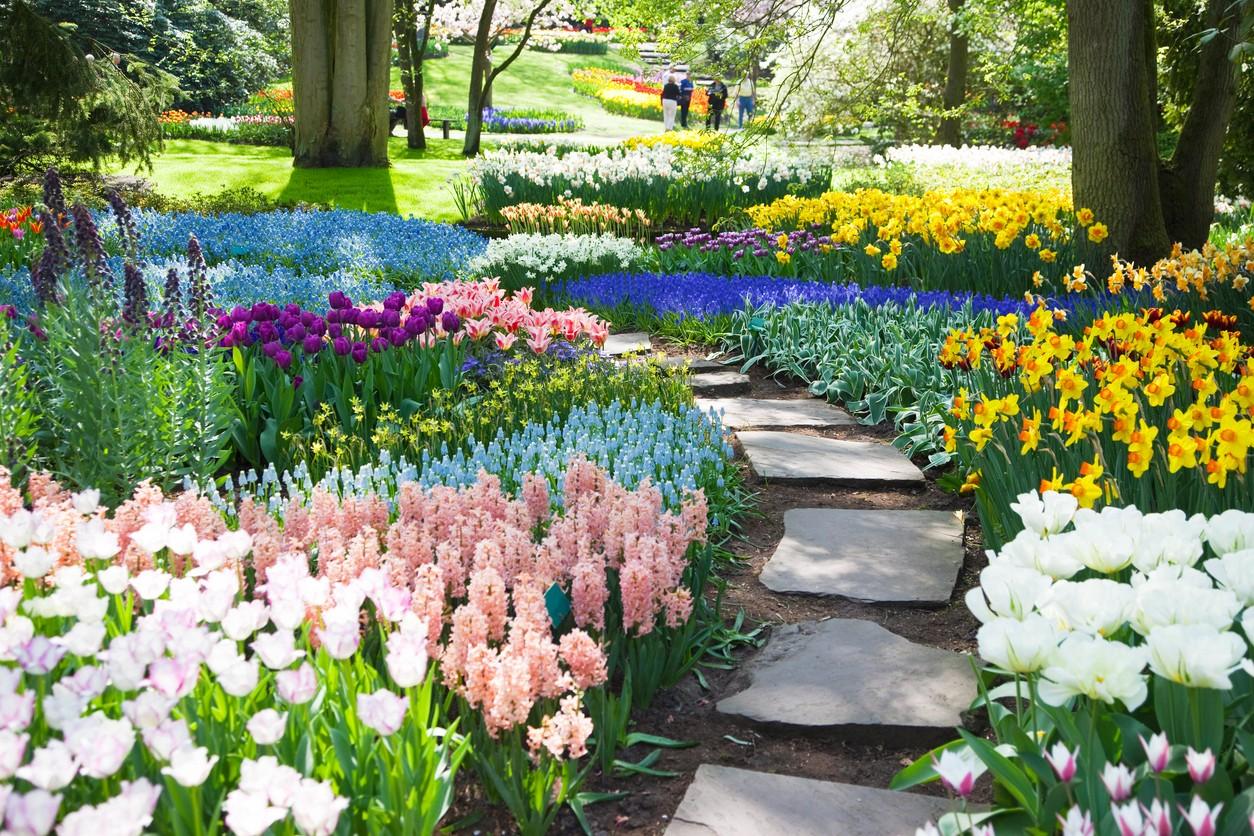Keukenhof Gardens, located in Lisse, Netherlands, is one of the world's largest and most spectacular flower gardens. Spanning over 32 hectares, this stunning park showcases the beauty and diversity of Dutch floriculture, with a particular focus on tulips. The gardens attract over a million visitors annually during its brief opening period, typically from mid-March to mid-May. Keukenhof's history dates back to the 15th century when it served as a hunting ground and source of herbs for the kitchen of Teylingen Castle. In 1949, a group of prominent Dutch bulb growers and exporters conceived creating a spring flowering exhibit to promote their industry. Since then, Keukenhof has become an iconic symbol of Dutch heritage and a must-visit destination for garden enthusiasts and nature lovers from around the globe.
The Gardens' Design & Layout
Keukenhof Gardens is a masterpiece of landscape design, carefully crafted to showcase the beauty and diversity of Dutch floriculture. The gardens span over 32 hectares and are divided into different themed areas, each with its unique character and style. The layout of the gardens is designed to guide visitors through a series of stunning visual experiences, from the bold and colourful tulip beds to the tranquil water features. At the heart of Keukenhof is the central pond, which serves as a focal point for the gardens and a gathering place for visitors. Surrounding the pond are beautifully manicured lawns, dotted with sculptures and fountains that add to the overall aesthetic appeal of the gardens. From here, visitors can explore the various themed gardens, each carefully designed to highlight specific aspects of Dutch horticulture and design. The gardens seamlessly blend formal and informal elements. The structured tulip beds, with their precise geometric patterns and vibrant colours, are juxtaposed against the more naturalistic plantings of trees, shrubs, and perennials. This creates a dynamic and visually interesting landscape that is beautiful and engaging.
The designers of Keukenhof also pay close attention to the use of colour throughout the gardens. The tulip beds are carefully planned to create a stunning spectrum of hues, from deep purples and reds to soft pinks and yellows. These colours are echoed in the surrounding plantings, creating a sense of harmony and unity throughout the gardens. In addition to the outdoor spaces, Keukenhof also features several indoor pavilions that showcase different aspects of Dutch floriculture. These include the Beatrix Pavilion, which houses a stunning collection of orchids and other exotic plants, and the Oranje Nassau Pavilion, which features a rotating display of floral arrangements and installations. The Beatrix Pavilion is a particular highlight of Keukenhof's indoor spaces. Named after the former Queen of the Netherlands, this pavilion is home to a breathtaking collection of orchids, bromeliads, and other tropical plants. The plants are displayed in a series of themed exhibits, each of which showcases a different aspect of the beauty and diversity of these exotic species. Visitors can wander through the pavilion's lush greenhouses, marvelling at the vibrant colours and intricate patterns of the flowers and foliage. The Oranje Nassau Pavilion, on the other hand, offers a different kind of floral experience. This pavilion features a rotating display of floral arrangements and installations created by some of the Netherlands' most talented floral designers. The displays are designed to showcase the latest trends and techniques in floral design and often incorporate unusual materials and unconventional colour combinations. Visitors to the pavilion can watch the designers at work, and even participate in workshops and demonstrations to learn more about the art of floral arranging.
Keukenhof's design also incorporates water features throughout the gardens. The central pond is just one example of the many water features that can be found at Keukenhof. The gardens also include several smaller ponds, fountains, and streams, each of which adds to the overall sense of tranquillity and beauty. One of the most impressive water features at Keukenhof is the "Whisper Boat" canal, which winds its way through the heart of the gardens. Visitors can take a leisurely boat ride along the canal, enjoying the stunning views of the surrounding tulip beds and other plantings. The canal is lined with weeping willows and other water-loving plants, creating a lush and romantic atmosphere that is perfect for a relaxing afternoon stroll.
Exploring the Themed Gardens
English Landscape Garden
The English Landscape Garden at Keukenhof is a beautiful example of the naturalistic style of garden design that originated in 18th-century England. This style of gardening sought to create a more informal and picturesque landscape, in contrast to the formal and geometric gardens that were popular in continental Europe at the time. The English Landscape Garden at Keukenhof features sweeping lawns, gently curving paths, and informal plantings of trees, shrubs, and perennials. The garden is designed to create a sense of openness and space, with views that unfold gradually as visitors move through the landscape. As mentioned, the garden includes several small ponds and streams, which are surrounded by lush plantings of moisture-loving plants such as irises, primulas, and astilbes. These water features provide a habitat for a variety of wildlife, including birds, frogs, and dragonflies. The largest of these water features is the serpentine lake, which winds its way through the heart of the English Landscape Garden. The lake is surrounded by gently sloping lawns and informal plantings of trees and shrubs, creating a natural and picturesque setting that is reminiscent of the English countryside. Visitors can stroll along the lake's edge, enjoying the peaceful sound of the water and the beauty of the surrounding landscape.
The garden features a variety of deciduous and evergreen trees, including oak, beech, and pine, which are carefully placed to frame views and create a sense of enclosure. The trees are underplanted with a variety of shrubs and perennials, including rhododendrons, azaleas, and ferns, which add texture and interest to the landscape. The giant sequoia is one of the most impressive tree specimens in the English Landscape Garden and towers over the surrounding landscape. This majestic tree is a true wonder, with its massive trunk and soaring branches that seem to reach up to the sky. The English Landscape Garden at Keukenhof also includes several follies and other architectural features that are typical of this style of gardening. These include a charming thatched cottage, a rustic wooden bridge, and a classical temple, all of which add to the picturesque and romantic character of the garden. The thatched cottage is a particular highlight, with its quaint and cosy appearance that seems to have been lifted straight from the pages of a fairy tale. Visitors can peek inside the cottage's windows, imagining what life might have been like for the gardeners and groundskeepers who once lived and worked on the estate. The wooden bridge, meanwhile, is a charming and rustic feature that spans one of the garden's many streams. The bridge is constructed from rough-hewn logs and planks and has a slightly uneven surface that adds to its natural and organic feel. Visitors can cross the bridge and pause to enjoy the view of the stream below, watching as the water bubbles and flows over the rocks and pebbles.
Finally, the classical temple is a grand and imposing structure that sits atop a small hill overlooking the English Landscape Garden. The temple is modelled after the famous Temple of Vesta in Rome and features a circular colonnade of Ionic columns that surround a central altar. Visitors can climb the steps to the temple's entrance, enjoying the panoramic views of the surrounding landscape and imagining the grand parties and gatherings that might have taken place here in centuries past. Throughout the year, the English Landscape Garden is a popular spot for visitors to Keukenhof to relax, unwind, and enjoy the beauty of nature. Whether strolling along the winding paths, picnicking on the lawns, or simply sitting and taking in the view, visitors are sure to be enchanted by the timeless charm and elegance of this iconic garden-style.
Historical Garden
The Historical Garden at Keukenhof is a fascinating glimpse into the history of Dutch garden design. This garden is a recreation of a typical 19th-century Dutch garden, complete with formal parterres, clipped hedges, and classical statuary. The garden is laid out in a geometric pattern, with a central axis that leads from the entrance to a beautiful fountain at the far end. Along the way, visitors pass through a series of smaller gardens, each with its unique character and style.
The garden features a variety of carefully clipped hedges and shrubs, including boxwood, yew, and holly, which are shaped into intricate patterns and designs. These topiaries add a sense of structure and formality to the garden and create a striking contrast with the more naturalistic plantings in other parts of Keukenhof. The topiary designs in the Historical Garden are truly impressive, ranging from simple geometric shapes to more complex and whimsical forms. Visitors can marvel at the skill and precision of the gardeners who have created these living sculptures and appreciate the time and effort that goes into maintaining them throughout the year. One of the most famous topiary designs in the Historical Garden is the "Green Man," a large and intricately shaped figure that appears to be emerging from the surrounding hedges. The Green Man is a common motif in European folklore and art and is often associated with the spirit of nature and the cycle of life and death.
The garden also features a variety of sculptures, including busts of famous Dutch figures, as well as mythological creatures and other decorative elements. These sculptures are carefully placed throughout the garden, creating focal points and adding to the overall sense of grandeur and elegance. You will also see The "Four Seasons" fountain, one of the most impressive sculptures in the Historical Garden which features four larger-than-life figures representing the different seasons of the year. The figures are carved from white marble and are surrounded by a circular pool of water, creating a stunning centrepiece that is visible from all parts of the garden.
The plantings in the Historical Garden are also carefully chosen to reflect the style and character of a 19th-century Dutch garden. The garden features a variety of traditional Dutch plants, including tulips, hyacinths, and other spring-flowering bulbs, as well as a range of perennials and annuals that would have been popular during this period. The "Tulip Carpet” is an impressively large and colourful display of tulips that covers an entire section of the garden. The tulips are planted in intricate patterns and designs, creating a stunning visual effect that is reminiscent of a Persian carpet. Visitors can walk along the edges of the Tulip Carpet, admiring the beauty and complexity of the design, and imagining the skill and patience that went into creating it. The Historical Garden is also a testament to the long and rich history of Dutch horticulture. The Netherlands has been a centre of horticultural innovation and excellence for centuries, and the Historical Garden showcases some of the key developments and trends that have shaped Dutch garden design over the years.
Inspiration Garden
The Inspiration Garden at Keukenhof is a true highlight of the park, showcasing the latest trends and innovations in garden design. This dynamic and ever-changing space is designed to spark creativity and imagination and to provide visitors with fresh ideas and inspiration for their gardens at home. The Inspiration Garden is divided into several distinct areas, each with its unique theme and character. These themed gardens are created by some of the Netherlands' most talented landscape architects and designers, who are given free rein to experiment with new plants, materials, and design concepts.
One of the most popular areas of the Inspiration Garden is the "Beach Garden," which features a coastal-inspired landscape of sandy dunes, beach grasses, and salt-tolerant plants. The garden is designed to evoke the natural beauty of the Dutch coastline, with its wide-open spaces, rugged terrain, and ever-changing light and weather conditions. The Beach Garden is planted with a variety of native and adapted species that thrive in the challenging conditions of the coast. These include sea thrift, sea holly, and beach roses, as well as a range of ornamental grasses and sedges that provide texture and movement in the wind. The garden also features many sculptural elements, such as driftwood and sea shells, which add to the natural and organic feel of the space.
Another highlight of the Inspiration Garden is the "Cutting Garden," which showcases a range of flowers and foliage plants that are perfect for cutting and arranging. The garden is designed to inspire visitors to grow their cut flowers at home and features a variety of annuals, perennials, and bulbs that are easy to grow and provide a long season of bloom. The Cutting Garden is divided into several smaller beds, each with its own colour scheme and theme. One bed might feature a range of pink and purple flowers, such as cosmos, zinnias, and dahlias, while another might showcase a collection of fragrant herbs and foliage plants, such as lavender, rosemary, and eucalyptus. Visitors can stroll through the garden, admiring the beautiful blooms and gathering ideas for their cutting gardens at home. In addition to the Beach Garden and Cutting Garden, the Inspiration Garden also features some other themed areas, each with its unique character and style. The "Woodland Garden," for example, showcases a range of shade-loving plants and trees, such as ferns, hostas, and Japanese maples, while the "Fragrance Garden" features a collection of aromatic plants and flowers, such as jasmine, lilacs, and gardenias.
The Inspiration Garden incorporates sustainable and eco-friendly design principles. Many of the gardens feature native and adapted plant species that require minimal water and maintenance, as well as permeable paving and other features that help to manage stormwater and reduce runoff. The Inspiration Garden also showcases a range of innovative materials and construction techniques, such as green roofs, living walls, and vertical gardens. These features not only add visual interest and texture to the garden, but also help to improve air quality, reduce urban heat island effects, and provide habitat for birds and other wildlife Throughout the Inspiration Garden, visitors will find a range of informational displays and educational exhibits that provide insights into the design process and the various plants and materials used in each garden. These displays are designed to be engaging and interactive, with hands-on activities and demonstrations that allow visitors to learn more about the art and science of garden design.
The "Designer's Studio," is a popular space where visitors can meet and interact with some of the Netherlands' leading garden designers and landscape architects. The studio features a rotating series of exhibitions and installations that showcase the work of different designers, as well as workshops and demonstrations that allow visitors to learn more about the creative process behind each garden. Visitors to the Inspiration Garden will also find a range of amenities and services designed to enhance their experience and make their visit more enjoyable. These include a café and restaurant area, where visitors can relax and refuel with a range of delicious food and drink options, as well as a gift shop featuring a selection of garden-related books, tools, and souvenirs.
Tulip Mania Exhibition
The Tulip Mania exhibition at the Amsterdam Tulip Museum is a fascinating journey through one of the most intriguing episodes in Dutch economic history. The exhibition tells the story of the world's first recorded speculative bubble, which took place in the Netherlands during the 1630s. At the heart of this bubble was the tulip, a flower that had only recently been introduced to Europe from the Ottoman Empire. The exhibition begins by setting the scene of the Dutch Golden Age, a period of unprecedented prosperity and cultural flourishing in the Netherlands. It was during this time that the tulip first captured the imagination of Dutch society, with its vibrant colors and exotic allure. As demand for the flower grew, so too did its price, with rare varieties commanding sums that could purchase entire estates.
The Tulip Mania exhibition explores the various factors that contributed to the speculative frenzy surrounding tulips. It examines the role of the newly established Dutch East India Company in bringing tulips and other exotic goods to Europe, as well as the social and cultural significance of the flower among the Dutch elite. Visitors can see examples of the elaborate tulip catalogues and price lists that fueled the mania, as well as contemporary accounts of the incredible sums being paid for single bulbs. As the exhibition progresses, it delves into the mechanics of the tulip trade itself. It explains how the trade was conducted through a system of futures contracts, with buyers and sellers agreeing on prices for bulbs that had yet to be harvested. This system allowed for rampant speculation, with traders buying and selling contracts for tulips they never intended to possess. The climax of the exhibition is the inevitable burst of the tulip bubble in 1637. Through a combination of factors, including market saturation and a shift in public sentiment, the price of tulips suddenly collapsed, leaving many investors ruined. The exhibition explores the aftermath of this collapse, including the social and economic fallout that followed.
One of the highlights of the exhibition is a recreation of a 17th-century tulip garden, complete with a dazzling array of tulip varieties. This garden provides a stunning visual representation of the beauty and diversity of the tulip and helps to explain why the flower became such an object of obsession during the Dutch Golden Age. The Tulip Mania exhibition is a must-see for anyone interested in the history of economics, horticulture, or Dutch culture. It offers a fascinating glimpse into a time when a single flower could command fortunes, and when the line between investment and speculation was blurred beyond recognition. Through its engaging displays and informative exhibits, the exhibition brings this remarkable story to life, providing visitors with a deeper understanding of one of the most curious episodes in financial history.
Planning Your Visit to Keukenhof Gardens
Choosing the Best Time to Visit — When choosing a day to visit, keep in mind that weekends and holidays tend to be the busiest times, with larger crowds and longer wait times. If possible, try to visit on a weekday or early in the morning to avoid the rush. The weather can also be a factor, as the flowers will be at their best on a sunny day, but the gardens can still be enjoyed in light rain or overcast conditions.
Photography Tips — Don't forget to bring your camera to capture the stunning beauty of the flowers and gardens. Keukenhof is a photographer's paradise, with endless opportunities for creative shots and memorable moments. Whether you're a seasoned pro or a casual snapper, you're sure to come away with some incredible images to treasure and share.
Accessibility — Keukenhof Gardens is easily accessible by car or public transport from major Dutch cities such as Amsterdam, The Hague, and Rotterdam. Visitors can also take advantage of organised tours and packages that include transportation and admission to the gardens.
Related Articles

Let us know you agree to cookies
We use marketing, analytical and functional cookies as well as similar technologies to give you the best experience. Third parties, including social media platforms, often place tracking cookies on our site to show you personalised adverts outside of our website.
We store your cookie preferences for two years and you can edit your preferences via ‘manage cookies’ or through the cookie policy at the bottom of every page. For more information, please see our cookie policy.
